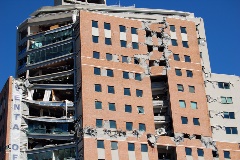Amwins Brokerage
As the nation's largest wholesale broker, our specialized expertise is yours to tap into — from unparalleled market access to value-added resources and intel.
Amwins Brokerage
As the nation's largest wholesale broker, our specialized expertise is yours to tap into — from unparalleled market access to value-added resources and intel.
Expertise. Marketplace clout.
Unparalleled resources.
That's the Amwins advantage.
As a retailer, you're responsible for navigating changing landscapes, regardless of your client's industry or coverage needs. At Amwins, we know the weight of these constant shifts in market conditions makes placing specialty insurance feel like an uphill battle. But you don't have to go it alone. Amwins Brokerage is adept at navigating these intricacies. Bring us your difficult placements — your complex, layered and niche accounts across all lines.
Our Brokerage divisions includes more than 425 teams nationwide. Through specialty practice groups, our brokers are constantly collaborating, sharing knowledge and solutions across teams and divisions. That means when you work with an Amwins broker, you have the combined expertise of our entire firm driving your success.
With the largest specialty insurance distribution platform in the industry, we stay on top of market conditions and trends to keep our retailers ahead of the game. The result? The value-added resources, market relationships, and solutions to get tough deals done.
CAT modeling + risk control resources
Our in-house team of actuaries licenses cutting-edge software to deliver catastrophe risk data analysis and the most accurate pricing possible.
Proprietary product development
Combining our product expertise, market clout and in-house facilities, we develop exclusive products that support the evolving needs of our clients and their insureds.
Data + analytics
By analyzing data from thousands of Amwins-placed accounts, we bring our clients valuable insight through tools such as benchmarking reports and price trends.
#1
largest wholesale broker in the U.S.
$23.8B
annual premium placements
1,200+
admitted, E&S and wholesale-only carrier relationships
Explore Amwins resources + insights
Stay up to date on emerging industry trends and topics.
Top 10 Misconceptions About Placing California Earthquake Insurance Coverage
One of the biggest misconceptions regarding California Earthquake coverage is the widely held view that it is a straightforward and elective coverage. With the lowest frequency in the CAT space, this peril is the least tested and, as a result, often misunderstood. While frequency is minimal, one large event with subsequent aftershocks would have brokers and insureds taking a closer look at what is truly being offered.
The amount of capacity, alternative capital, and the number of carriers and MGAs continues to grow. This increased number of choices creates competition and flexibility in coverage. However, this competition also makes it easy to place coverage without fully understanding what is provided.
Below are the top 10 misconceptions about placing CA Earthquake coverage.
- Only the basic data is needed to generate accurate CA Earthquake modeling results. If you input basic data without asking about missing information regarding construction, year built, engineering, etc., your results will reflect this. Scrubbing your data and taking the time to obtain more detailed information, along with identifiable secondary characteristics, could produce a much better result. Simply using the most basic information often results in the model “defaulting” and advising an inaccurate, worst-case scenario. Additional information provides underwriters with a better comfort level and, often, more room to negotiate.
- A CA Earthquake policy fills the gap in an All Risk policy excluding Earthquake. Many times, the two policies will have a different definition of Earthquake. There may be gaps in coverage if the excluded definition in the All Risk is not the same as what the Earthquake carrier is offering.
- CA Earth Movement coverage is basically the same thing as CA Earthquake. CA Earthquake typically limits coverage to a tectonic event, while some Earth Movement definitions can be as broad as to include ANY Earth Movement, including a tsunami. When an insured requests Earth Movement coverage, a broker should clarify intent and make recommendations based on the nature of their exposure.
- CA Earthquake application of deductibles are always clearly defined and outlined. It is important for clients to understand how the deductible applies on their risk, as the application will differ based on the carrier’s definition. Deductibles may be applied in various ways, including but not limited to on a per inured unit, per building, per location or per TIV basis. Clients often mistakenly believe that the percentage deductible applies to the loss amount, when in fact it applies to the values at risk at time of loss. Clients also should be aware that the values at risk at the time of loss may be different than the values originally reported at the inception. For example, an insured that has inventory fluctuations may be surprised to learn that while their original values were reported at $50,000,000, the values increased within the policy year to $100,000,000 during their peak season. The increase in values would essentially double their deductible if the loss occurred during this time.
- A copy of the Primary All Risk Form is not needed when placing Excess CA Earthquake. Many Excess CA Earthquake carriers utilize their own company form sitting above the All Risk policy for the peril they are covering, without concurrency or consistency. Without manuscripting to clearly outline how the CA Earthquake coverage would respond should the All Risk policy be affected in the event of a loss, gaps in coverage can exist.
- CA Earthquake Recommendation reports are the same as Seismic CA Earthquake Engineering reports. Many times, Loss Assessment reports are provided, advising steps to be taken to implement from a life safety perspective. These are different than an Engineering Report, which provides exact details of Loss Control implementation, with firm dates and measures taken to stabilize. Carriers can better review and credit risks when they have an Engineering report.
- All carriers use the same CA Earthquake model. Most carriers utilize RMS, while others use AIR, along with proprietary modeling. Knowing the model that each carrier utilizes will allow a broker to structure a competitive placement and provide different layering options.
- All CA Earthquake carriers quota sharing a placement offer the same coverage. Many carriers have different definitions of Earthquake, occurrence, deductible, and stepdown/dropdown provisions, which can create inconsistencies in the event of a loss. This is especially true of shared and layered placements. It is imperative that brokers achieve concurrency in wordings, as coverage gaps caused by different definitions will ultimately fall on the placing broker.
- Business Income/Extra Expense values will not have a significant impact in the event of a claim. A failure to understand these values could have the greatest impact in the event of a loss. It is important to know if there are locations that are contingent upon others and whether the reported values represent 6-month, 12- month, or 24-month values.
- Sample policy forms are not necessary when issuing a CA Earthquake quotation. Brokers may believe that they can explain the coverage over the phone or in email, if there are questions. While there may be a general understanding of the coverage provided, without referring to the policy itself, details can get lost in translation. It important to deliver a fully executed policy with respective forms outlined – not merely a three-to-four-page quote –for client review. At a minimum, the underwriter and broker must agree on the Earthquake or Earth Movement definition in advance.
About the Author
This article was written by Greg DeFuria, property broker with AmWINS Brokerage in Woodland Hills, CA.
- Property
- Property & Casualty
More to Explore
Collaboration and market leverage for the win.
With less than three days to bind, a retailer with a large wood-frame podium project account on the Tampa Bay came to Amwins in need of builder’s risk coverage. The competitor’s quote had room for improvement in pricing, terms and conditions. Utilizing our exclusive property capacity, we were able to negotiate a very competitive $10M primary layer the next day.
When reviewing the account, it came to light that the competitor had only quoted 10% of the flood coverage required, set the expiration date two months shy of the term needed, and had a deductible twice the amount the insured could carry. We determined with the retailer that the best approach was to completely restructure the program.
In the end, we were able to secure $50M in primary with the flood limits, water damage deductible and expiration date the insured needed. For the excess layer, Amwins Bermuda called on a long-standing relationship with a Bermuda market to achieve the terms and limits needed at a competitive price.
Amwins’ teamwork, leverage in the marketplace and proprietary products allowed us to place this risk in just over 48 hours with substantial premium savings and enhancements to coverage.



